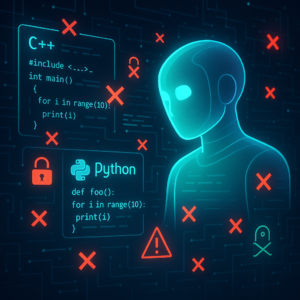Navigating Trust in AI: Meet SafeChat, Your New Reliable Chatbot Buddy!

Navigating Trust in AI: Meet SafeChat, Your New Reliable Chatbot Buddy!
In our fast-paced digital world, we rely more and more on technology to make our lives easier—especially when it comes to gathering information. From finding a new recipe to sorting out our taxes, the countless chatbots and AI assistants available seem to promise knowledge at the tip of our fingers. But here’s the catch: how can we really trust these virtual buddies? Enter SafeChat, a fresh framework designed to help create trustworthy chatbots. Let’s dive into what this means for our interactions with AI!
What’s the Deal with Chatbots?
Before we dig into SafeChat, let’s get on the same page about chatbots. These are computer programs that simulate human conversations using text or voice—think of them as your digital buddies that can help answer questions or perform tasks. We’ve all seen how they work in customer service or as virtual assistants on our devices.
However, chatbots, especially those powered by Large Language Models (LLMs) like ChatGPT and Gemini, often stumble when we need them the most. Issues like misinformation, inability to explain how they arrived at an answer, and even the potential to spit out harmful content raise serious red flags when it comes to trust. Users are left feeling uncertain, especially in critical areas like healthcare or elections.
So, what’s the solution?
Introducing SafeChat: The Trustworthy Chatbot Framework
SafeChat is a new architectural approach to building chatbots, geared specifically towards making them reliable and safe for users. Let’s get into the nitty-gritty of how it works.
Safety First!
At the core of SafeChat is safety. This framework has a clever self-defense mechanism that ensures every response comes from verified and allowed sources. Imagine talking to a friend who only repeats well-researched facts—they’re not going to tell you anything they can’t back up, right? SafeChat does just this by establishing “provenance,” which essentially tracks the source of the information provided.
It even knows when to step back, using do-not-respond strategies. If a user asks a potentially harmful or inappropriate question, it simply sidesteps the inquiry rather than risk giving a misleading or damaging response.
Usability is Key
Imagine this: you’re getting a long-winded answer, and all you want is the gist of it. SafeChat can summarize lengthy responses into bite-sized nuggets, making the information easier to digest. Plus, it has a nifty feature for automated trust assessments, which communicates how likely the chatbot is to provide accurate information based on sentiment analysis.
This means you won’t just get an answer; you’ll know how trustworthy that response is, making for a more conscious and informed interaction.
Fast and Scalable Development
No one likes waiting for solutions! That’s why SafeChat incorporates a CSV-driven workflow along with automated testing. This means developers can quickly build and refine chatbots, making them accessible and ready for deployment in various applications—from elections to healthcare and beyond.
A Real-World Example: ElectionBot-SC
To showcase its capabilities, SafeChat was rolled out in an exciting case study—ElectionBot-SC. This chatbot was designed to assist citizens in South Carolina with accurate and non-partisan information regarding the election process.
Building the Dataset
Before ElectionBot-SC could help voters, it needed a solid foundation. Developers gathered FAQs from official election offices and reputable non-profits, creating a comprehensive dataset. They started with 30 Q&As and expanded to over 414, covering a range of election-related topics. Think of it like filling a recipe book with just the best, most reliable recipes!
Engaging Users Effectively
ElectionBot-SC was implemented as a web application, featuring a clean and friendly interface. It provides a chat area where users can interact and ask questions, along with a sidebar giving insights into the chatbot’s capabilities. A critical aspect? Users get a confidence score for the responses they receive, which aids them in assessing how trustworthy that information is.
Gathering Feedback for Continuous Improvement
After rolling out the chatbot during election season, researchers tested it with actual users to gather feedback on its usefulness. They asked participants to rate the accuracy and relevance of the chatbot’s responses, gaining valuable insights into what worked and what could be improved. The aim? To keep refining the chat experience, making it better as it goes along.
The Implications: Why This Matters
The advancements presented by SafeChat open up exciting possibilities for our interactions with AI. As chatbots become integrated into various sectors—from finance to healthcare to civic engagement—the need for trust grows significantly.
Imagine walking into a voting place and knowing you can ask an AI-based assistant any burning questions about the voting process, and receive accurate, safe guidance without worry! This isn’t just a dream; it’s becoming a reality with frameworks like SafeChat leading the way.
Key Takeaways
-
Trust Is Crucial: Safety mechanisms built into chatbots ensure users can trust that the information they receive is accurate and reliable.
-
User Empowerment: Features like automated trust assessments and extractive summarization enhance user engagement by making information accessible and straightforward.
-
Rapid Development: The CSV-driven workflow allows developers to create and update chatbots quickly, making this tech adaptable across different domains.
-
Real-World Applications: Case studies like ElectionBot-SC showcase how SafeChat can improve civic engagement, leading to better-informed citizens.
-
Ongoing Refinement: Gathering user feedback is essential for continually enhancing the chatbot experience, ensuring it meets dynamic information needs.
As these technologies continue to evolve, keeping a focus on trust and usability will undoubtedly be key to their success. The future looks brighter as we increasingly rely on our digital companions to provide the information we need, when we need it—safely and reliably!
If you are looking to improve your prompting skills and haven’t already, check out our free Advanced Prompt Engineering course.
This blog post is based on the research article “SafeChat: A Framework for Building Trustworthy Collaborative Assistants and a Case Study of its Usefulness” by Authors: Biplav Srivastava, Kausik Lakkaraju, Nitin Gupta, Vansh Nagpal, Bharath C. Muppasani, Sara E. Jones. You can find the original article here.




